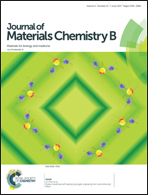Characterization of complexes made of polylysine–polyleucine–polylysine and pDNA†
Abstract
Polylysine shows unique physical and biological abilities in its application. In this study, different kinds of tri-block co-polypeptides are used as gene delivery vectors with hydrophobic polyleucine (L) in the middle and polylysine (K) on both sides. We explored their physical properties in aqueous solution as well as their biological effects toward gene transfection efficiency. After reaching critical micelle concentration, it is found that these tri-block polypeptides could form vesicles, and the size of each sample is independent of concentration. The self-assembly of each kind of tri-block co-polypeptide could obtain higher molecular weight vectors for gene delivery. After measuring the transfection efficiency and cell viability, these samples showed a high gene transfer ability, together with similar or lower cytotoxicity. Additionally, pDNA binding strength tests and zeta-potential assays reveal that the addition of an L part would reduce the charge density of the vector chains and thus lower the binding strength, leading to the easier release of pDNA from the complexes and an increase in transfection efficiency.



 Please wait while we load your content...
Please wait while we load your content...